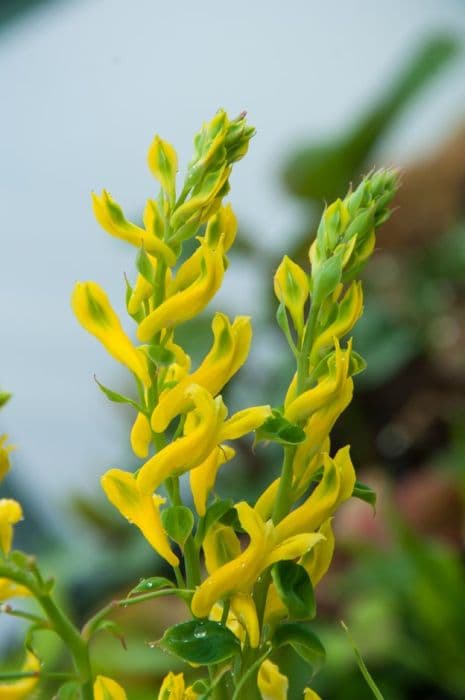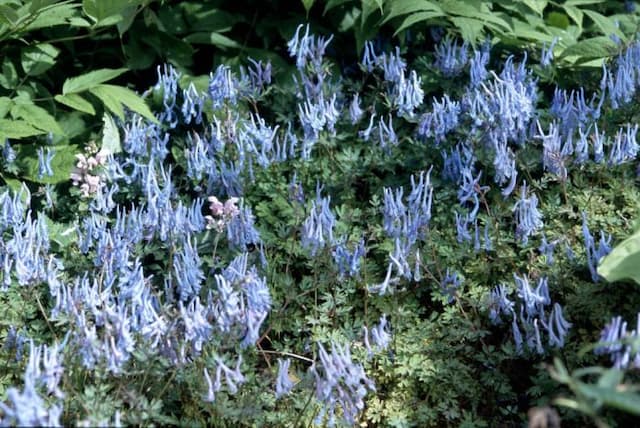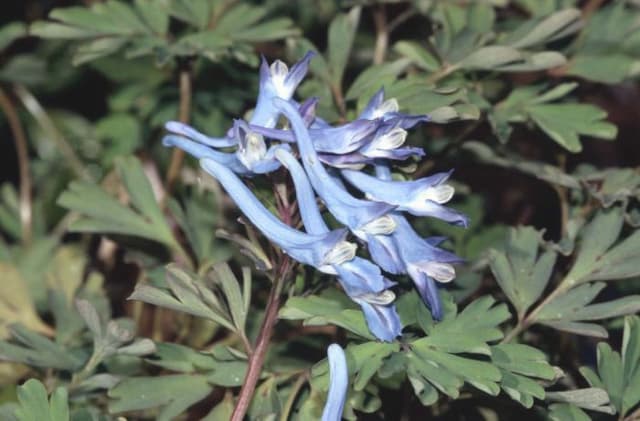Moroccan poppy Papaver atlanticum

ABOUT
The plant known as Moroccan poppy is a captivating perennial flower native to the Atlantic coast of Morocco. Bearing a soft, hairy foliage, the leaves of this plant appear bluish-green with a slightly grayish undertone. The texture of the leaves is somewhat ruffled, giving them a crinkly appearance that adds to the plant's plush aesthetic. This Moroccan poppy showcases a solitary flower at the end of each stem, which blooms into a striking cup-shaped blossom. The petals are delicate and papery, exuding a mesmerizing shade of bright orange to sunset hues. The heart of the flower features conspicuous reproductive parts including stamens and a central ovary that are often a contrasting tone, such as dark purple or black, creating an eye-catching display against the fiery petals. The Moroccan poppy's appearance is further characterized by its flowering period when it displays these attractive blooms that seem to dance on slender stems swaying with the breeze. Its charming appearance can add a splash of vibrant color and a wildflower essence to any garden setting where it tends to create an informal and naturalistic ambiance.
About this plant
 Names
NamesSynonyms
Atlas Poppy, Moroccan Poppy
Common names
Papaver atlanticum, Papaver rupifragum var. atlanticum, Papaver rupifragum.
 Toxicity
ToxicityTo humans
The common name for Papaver atlanticum is Moroccan poppy. While poppies in general are known for containing compounds that can be toxic or have narcotic effects, the toxicity of Moroccan poppy to humans specifically is not well-documented in scientific literature. However, it is advisable to err on the side of caution and consider it potentially harmful if ingested, as with many other Papaver species. Ingesting parts of plants from the Papaver genus can sometimes lead to symptoms such as nausea, vomiting, drowsiness, confusion, respiratory depression, and in severe cases, coma or death. It is critical to note that the harvesting and consumption of any Papaver species for their narcotic properties are illegal and dangerous.
To pets
Moroccan poppy, scientifically known as Papaver atlanticum, can be considered potentially toxic to pets, similarly to other members of the Papaver genus. The toxicity of the Moroccan poppy to pets like cats and dogs is not specifically detailed, but general symptoms of poppy poisoning in animals may include lethargy, changes in behavior, slowed breathing, coughing, dilated pupils, ataxia (loss of coordination), and in severe cases, coma or death. If a pet ingests this plant, it is critical to seek veterinary care immediately.
 Characteristics
CharacteristicsLife cycle
Perennials
Foliage type
Deciduous
Color of leaves
Green
Flower color
Orange
Height
1-2 feet (0.3-0.6 meters)
Spread
1-1.5 feet (0.3-0.45 meters)
Plant type
Herb
Hardiness zones
5
Native area
Morocco
Benefits
 General Benefits
General Benefits- Attracts Pollinators: Papaver atlanticum, commonly known as Atlas poppy, is known to attract bees and other pollinators, enhancing pollination in gardens.
- Aesthetic Appeal: With its bright orange-yellow blossoms, Atlas poppy adds vibrant color and visual interest to garden landscapes.
- Drought Tolerance: Once established, Atlas poppy can tolerate periods of drought, making it suitable for xeric gardens or areas with water restrictions.
- Low Maintenance: Atlas poppy requires minimal upkeep and can thrive in poor soils, reducing the need for fertilizers and regular upkeep.
- Self-Seeding: Atlas poppy can self-seed and propagate naturally, ensuring a continual presence without the need for constant replanting.
- Erosion Control: The root systems of Atlas poppy can help prevent soil erosion, making it a functional choice for slopes and banks.
 Medical Properties
Medical Properties- This plant is not used for medical purposes.
 Air-purifying Qualities
Air-purifying QualitiesThis plant is not specifically known for air purifying qualities.
 Other Uses
Other Uses- The Atlas poppy's dried seed pods can be used in floral arrangements for their unique structure and aesthetic appeal, adding a rustic or wildflower touch to bouquets and centerpieces.
- Its strong stems and foliage might be used in the production of plant-based dyes, offering a potential source of natural colorants for fabrics or artisan crafts.
- The Atlas poppy is occasionally cultivated as a companion plant in gardens to attract beneficial insects, such as bees and butterflies, which are important pollinators for many crops and other plant species.
- The petals of the Atlas poppy can be used in the craft of papermaking, providing texture and decorative elements to the handmade paper.
- It could serve as a teaching tool in botany or ecology courses to illustrate plant adaptation, due to the Atlas poppy's specific adaptations to its native environment in the Atlas Mountains.
- The striking flowers of the Atlas poppy can be pressed and used in the art of botanical illustration or as a natural element in homemade greeting cards and bookmarks.
- In landscape design, Atlas poppy can be used to prevent soil erosion on slopes due to its ability to grow in relatively harsh conditions and its clumping growth habit.
- As an ornamental plant, the Atlas poppy can be used to create a Garden of Remembrance or peace gardens due to the symbolic association of poppies with remembrance and peace.
- The Atlas poppy can be photographed and used for stock images or botanical photography studies because of its vibrant color and attractive shape.
- The petals of the Atlas poppy can be incorporated into potpourri mixes, adding color and a possibly mild fragrance to natural air freshening arrangements.
Interesting Facts
 Feng Shui
Feng ShuiThe Atlantic poppy is not used in Feng Shui practice.
 Zodiac Sign Compitability
Zodiac Sign CompitabilityThe Atlantic poppy is not used in astrology practice.
 Plant Symbolism
Plant Symbolism- Peace: As a variety of poppy, the Papaver atlanticum often shares the symbolic meaning of peace associated with poppies due to their widespread use to commemorate soldiers who have died in war.
- Rest: The poppy is also a symbol of rest and sleep, a nod to the sedative properties found in some species of poppies.
- Remembrance: Adopted from the red poppy's connection to Remembrance Day, the Papaver atlanticum is similarly linked to memory and the remembrance of people and past experiences.
- Resilience: Poppies are known for their ability to thrive in difficult conditions, making them a symbol of resilience and the ability to overcome challenges.
 Water
WaterThe Moroccan Poppy should be watered deeply but infrequently to encourage a strong root system. During active growth in the spring and fall, watering once per week should be sufficient, with an approximate amount of 1 gallon per plant. In the summer, especially in hotter climates, you may need to increase watering to twice per week. Always check the soil moisture before watering; the top inch should be dry to the touch. During the winter, reduce watering significantly and only water if the soil is very dry, as the plant is dormant.
 Light
LightThe Moroccan Poppy thrives in full sun, requiring at least 6 hours of direct sunlight daily for optimal growth. It's best to position this plant in a spot where it can enjoy uninterrupted sunlight throughout the day, as this will ensure vibrant blooms and healthy foliage.
 Temperature
TemperatureThe Moroccan Poppy prefers temperate climates and does well in a range where the temperature stays between 50°F and 75°F. It can survive minimum temperatures down to around 20°F and maximum temperatures up to 100°F. However, prolonged exposure to temperatures outside of the 50°F to 75°F range may stress the plant.
 Pruning
PruningPruning Moroccan Poppy is necessary to remove spent flowers and encourage a second bloom. Deadheading, or cutting off the faded flowers, should be done regularly throughout the blooming season. Pruning back to the foliage after the first bloom can promote a tidy appearance and may lead to a second flush of flowers. Optimal pruning time is immediately after the first flowering period has ended.
 Cleaning
CleaningAs needed
 Soil
SoilThe Moroccan Poppy prefers well-drained, sandy to loamy soil with a pH ranging from slightly acidic to neutral. A mix of two parts garden soil, one part sand, and one part compost or peat moss is ideal to ensure good drainage and fertility. Adjust the pH if necessary, aiming for 6.0 to 7.0 for optimal growth conditions.
 Repotting
RepottingMoroccan Poppies are not commonly repotted as they are often grown as annuals. However, if grown as perennials, they should be repotted every 2-3 years to refresh the soil and accommodate root growth. Avoid frequent disturbance to their roots.
 Humidity & Misting
Humidity & MistingMoroccan Poppies do not require high humidity; they thrive in average atmospheric conditions. Aim for a humidity level between 30% and 50% which is typical of indoor environments. Avoid overly humid conditions to prevent fungal diseases.
 Suitable locations
Suitable locationsIndoor
Provide full sun, well-drained soil, and minimal watering.
Outdoor
Plant in full sun, well-draining soil, water when dry.
Hardiness zone
6-9 USDA
 Life cycle
Life cycleThe life cycle of Papaver atlanticum, commonly known as the Moroccan poppy, begins with seed germination, triggered by exposure to light and usually after a period of cold stratification, mimicking its native habitat conditions. Once germinated, the embryo emerges from the seed as a radicle, which develops into the root system, while the shoot pushes upward towards the light. As the seedling grows, true leaves emerge and photosynthesis begins, providing energy for further growth and development. The Moroccan poppy then enters the vegetative stage, forming a rosette of blue-green leaves and eventually producing a flowering stalk. Following pollination, typically by insects, the flowers develop into capsules containing numerous tiny seeds, which are then dispersed by wind, completing the cycle when these seeds find suitable conditions to germinate and grow into new plants.
 Propogation
PropogationPropogation time
Spring to Summer
Papaver atlanticum, commonly known as the Moroccan poppy, is most commonly propagated by seed. The most favorable time for sowing the seeds is either in autumn for germination in spring or directly in spring after the last frost when the soil has warmed to at least 60°F (15°C). Scatter seeds on prepared soil and lightly cover with a thin layer of earth, as they need light to germinate. Keep the soil moist but not waterlogged until germination occurs, which is usually within 14-28 days. Once seedlings have grown and are strong enough to handle, thin them out to about 8 inches (20 cm) apart to allow sufficient space for the plants to develop fully.









